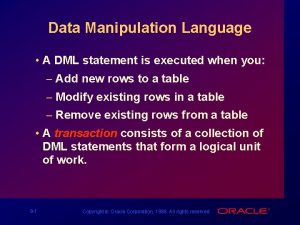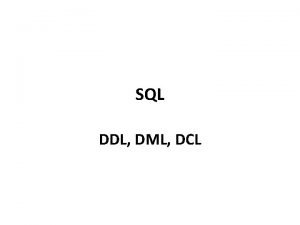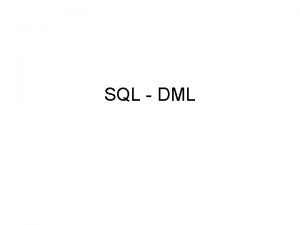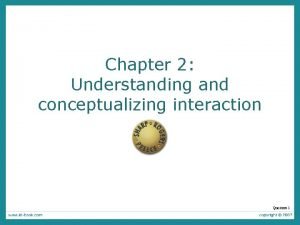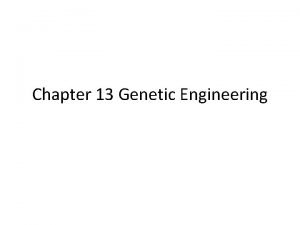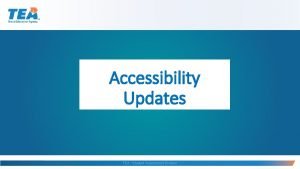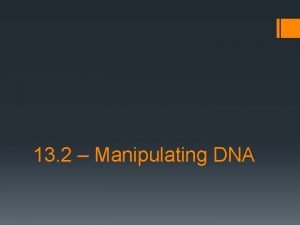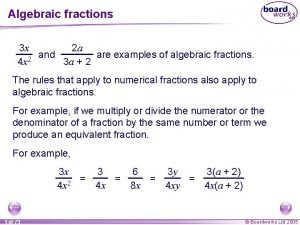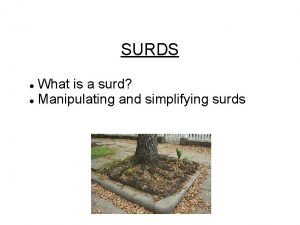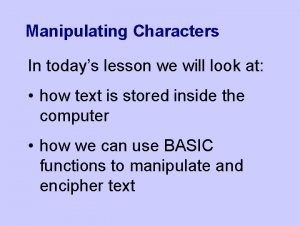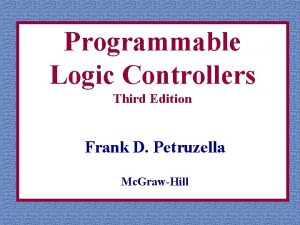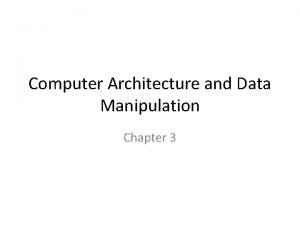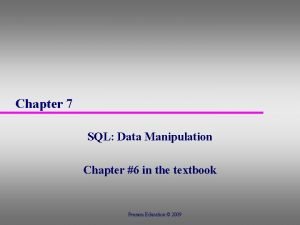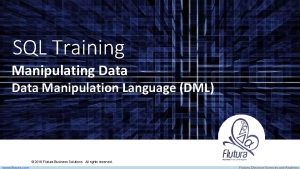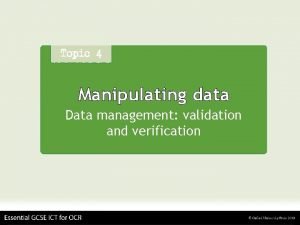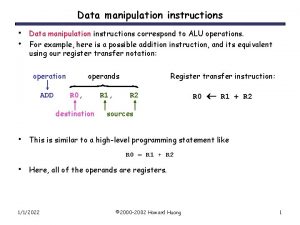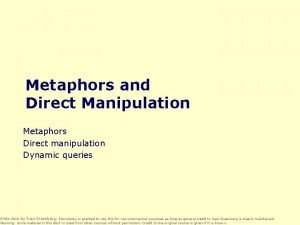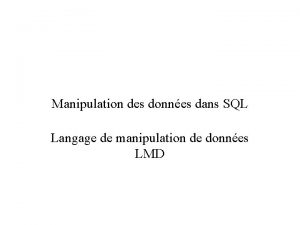MANIPULATING DATA Lecture 6 Data Manipulation Language A























- Slides: 23

“MANIPULATING DATA” Lecture 6

Data Manipulation Language � A DML statement is executed when you: • Add new rows to a table • Modify existing rows in a table • Remove existing rows from a table

Data Manipulation Language � A DML statement is executed when you: • Add new rows to a table • Modify existing rows in a table • Remove existing rows from a table


The INSERT Statement Syntax • INSERT statement is used to ADD new rows to a table. Syntax INSERT INTO table [(column 1 [, column 2. . . ])] VALUES (value 1 [, value 2. . . ]); § Only one row is inserted at a time with this syntax.

Inserting New Rows � Insert a new row containing values for each column. • List values in the default order of the columns in the table. • Optionally, list the columns in the INSERT clause. INSERT INTO departments(department_id, department_name, manager_id, location_id) VALUES (70, 'Public Relations', 100, 1700); § Enclose character and date values within single quotation marks.

Inserting Rows with “Null Values” � Implicit method: Omit the column from the column list. INSERT INTO departments (department_id, department_name ) VALUES (30, 'Purchasing'); Listing column names is mandator y § Explicit method: Specify the NULL keyword in the VALUES clause. INSERT INTO departments VALUES (100, 'Finance', NULL); column names are not listed because it’s optional

Note : listing the column names in the INSERT clause became mandatory in two cases: 1 - Insert a row containing values for some columns 2 - Insert a row containing values for all columns but don’t know the defult order of the columns

Data Manipulation Language � A DML statement is executed when you: • Add new rows to a table • Modify existing rows in a table • Remove existing rows from a table


Updating Rows in a Table : Syntax � Update statement is used to change a table’s data Syntax UPDATE tablename SET column 1 = new_value [, column 2 = new_value, . . . ] [WHERE condition]; � condition identifies the rows to be updated and is composed of (column names expressions, constants, subqueries, and comparison operators ) � In general, use the primary key to identify a single row. Using other columns can unexpectedly cause several rows to be updated

Updating Rows in a Table : Example of updating all rows � Increase the salary of all employees by 100 $ Update employees Set salary=salary+100; • Duplicate the salary of all employees …………………………………

Updating Rows in a Table : Example of updating specific rows � The WHERE clause is used with the Update statement to change the data of a specific row(s) UPDATE employees SET department_id = 70 WHERE employee_id = 113; 1 row updated � Omitting the WHRE clause will change the data in all rows UPDATE employees SET department_id = 110; 22 rows updated.

Updating Rows in a Table (Integrity Constraint Error) UPDATE employees SET department_id = 55 WHERE department_id = 110; UPDATE employees * Department number 55 does not exist ERROR at line 1: ORA-02291: integrity constraint (HR. EMP_DEPT_FK) violated - parent key not found

Updating Rows in a Table (Integrity Constraint Error(Cont. )) • If you attempt to update a record with a value that is tied to an integrity constraint, an error is returned. • In the example on the slide, department number 55 does not exist in the parent table, DEPARTMENTS, and so you receive the parent key violation ORA-02291.

Data Manipulation Language � A DML statement is executed when you: • Add new rows to a table • Modify existing rows in a table • Remove existing rows from a table


Removing a Row from a Table • You can remove existing rows from a table by using the DELETE statement. DELETE [FROM] tablename [WHERE condition]; • condition identifies the rows to be deleted and is composed of (column names expressions, constants, subqueries, and comparison operators ) • If no rows are deleted, a message “ 0 rows deleted. ” is returned

Removing a Row from a Table � Example: DELETE FROM departments WHERE department_id IN (30, 40); 2 rows deleted

Removing a Row from a Table � Specific rows will be deleted if you specify the WHERE clause. DELETE FROM departments WHERE department_name = 'Finance'; 1 row deleted. § All rows in the table will be deleted if you omit the WHERE clause. DELETE FROM copy_emp; 22 rows deleted.

Removing a Row from a Table ( Integrity Constraint Error) DELETE FROM departments WHERE department_id = 60; You cannot delete a row DELETE FROM departments that contains a primary key * that is used as a foreign key in another table. ERROR at line 1: ORA-02292: integrity constraint (HR. EMP_DEPT_FK) violated child record found

Removing a Row from a Table ( Integrity Constraint Error) � If you attempt to delete a record with a value that is tied to an integrity constraint , an error is returned. � The example in the slide tries to delete department number 60 from the DEPARTMENTS table, but it results in an error because department number is used as a foreign key in the EMPLOYEES table. If the parent record that you attempt to delete has child records, then you receive the child record found violation ORA-02292.

Removing a Row from a Table ( Integrity Constraint Error) • The following statement works because there are no employees in department 70: DELETE FROM departments WHERE department_id = 70;
 Manipulating large data sets
Manipulating large data sets Data manipulation language dml
Data manipulation language dml Pengertian dcl
Pengertian dcl Data manipulation language in sql
Data manipulation language in sql 01:640:244 lecture notes - lecture 15: plat, idah, farad
01:640:244 lecture notes - lecture 15: plat, idah, farad Ooa and ood
Ooa and ood When does lady macbeth manipulate macbeth
When does lady macbeth manipulate macbeth Instructing conversing manipulating exploring
Instructing conversing manipulating exploring Section 13-2 manipulating dna
Section 13-2 manipulating dna 13-2 manipulating dna
13-2 manipulating dna What are accessibility features for staar
What are accessibility features for staar Section 13-4 applications of genetic engineering
Section 13-4 applications of genetic engineering Equiibrium constant
Equiibrium constant Scalp care shampooing and conditioning chapter 15
Scalp care shampooing and conditioning chapter 15 Algebraic fractions addition
Algebraic fractions addition Surd rule
Surd rule Process of manipulating images and sounds
Process of manipulating images and sounds Ascii code for space
Ascii code for space Data manipulation instructions enable the plc to
Data manipulation instructions enable the plc to Polynomial addition using linked list in c++
Polynomial addition using linked list in c++ Data manipulation vulnerability
Data manipulation vulnerability Data manipulation instructions in plc
Data manipulation instructions in plc Data manipulation in computer architecture
Data manipulation in computer architecture The sql data manipulation command having
The sql data manipulation command having

